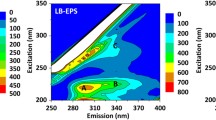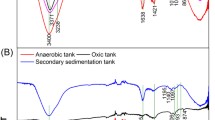Abstract
The study aims to clarify how the type of organic substrate in a wastewater affects the production and composition of extracellular polymeric substances (EPS) and hydrophobicity and surface charge of activated sludges. For this purpose, three activated sludge reactors were operated in parallel with feeds composed of the organics (i) peptone, glucose, and acetate and (ii) peptone and (iii) glucose. EPS extracted from sludges were fractionated into very loosely bound, loosely bound, and tightly bound fractions and analyzed for protein and polysaccharide. Also, molecular weight distribution of proteins was determined by using high-pressure size exclusion chromatography (HPSEC). Regardless of the type of organic substrate, in each sludge, tightly bound EPS (TB-EPS) prevailed. The type of organic substrate affected the relative proportion of protein and polysaccharide and had an impact on hydrophobicity and surface charge. The sludge fed with peptone was distinctly more hydrophobic and had a lower negative surface charge than others. HPSEC fingerprints revealed that the variety and size of proteins were dependent on the type of feed. HPSEC also pointed to a shift of high molecular weight (MW) proteins from TB-EPS to others. In addition, results of a parallel study examining the inhibitory effect of Ag+ on three sludges were interpreted along with feed composition, EPS, and surface measurements. The response of each sludge to toxic Ag+ ion seemed to change with the type of feed.




Similar content being viewed by others
Explore related subjects
Discover the latest articles and news from researchers in related subjects, suggested using machine learning.References
American Public Health Association (APHA) (1998) Standard methods for the examination of water and wastewater. American Public Health Association, American Water Works Association, Water Environment Federation, 20th edn. Washington, D.C
Benoit E, Guellil A, Block JC, Bessiere J (1998) Methods Dielectric permittivity measurement of hydrophilic and hydrophobic bacterial suspensions: a comparison with the octane adhesion test. 32:205–211
Bezawada J, Hoang NV, More TT et al (2013) Production of extracellular polymeric substances (EPS) by Serratia sp.1 using wastewater sludge as raw material and flocculation activity of the EPS produced. J Environ Manage 128:83–91. doi:10.1016/j.jenvman.2013.04.039
Brown M, Lester J (1979) Metal removal in activated sludge: the role of bacterial extracellular polymers. Water Res 13:817–837. doi:10.1016/0043-1354(79)90217-3
Çeçen F, Kılıç B (2015) Inhibitory effect of silver on activated sludge: effect of organic substrate and the carbon to nitrogen ratio. J Chem Technol Biotechnol. doi:10.1002/jctb.4709
Çeçen F, Semerci N, Geyik AG (2010a) Inhibitory effects of Cu, Zn, Ni and Co on nitrification and relevance of speciation. J Chem Technol Biotechnol 85:520–528. doi:10.1002/jctb.2321
Çeçen F, Semerci N, Geyik AG (2010b) Inhibition of respiration and distribution of Cd, Pb, Hg, Ag and Cr species in a nitrifying sludge. J Hazard Mater 178:619–627. doi:10.1016/j.jhazmat.2010.01.130
Decho AW (2000) Microbial biofilms in intertidal systems: an overview. Cont Shelf Res 20:1257–1273. doi:10.1016/S0278-4343(00)00022-4
DuBois M, Gilles KA, Hamilton JK et al (1956) Colorimetric method for determination of sugars and related substances. Anal Chem 28:350–356. doi:10.1021/ac60111a017
Durmaz B, Sanin FD (2003) Effect of carbon to nitrogen ratio on the physical and chemical properties of activated sludge. Environ Technol 24:1331–1340. doi:10.1080/09593330309385677
Ekama G, Wentzel MC (2008) Nitrogen removal. In: Henze M, van Loosdrecht MCM, Ekama G, Brdjanovic D (eds) Biological wastewater treatment: principles, modelling and design. IWA Publishing, p 87–139
Frølund B, Palmgren R, Keiding K, Nielsen PH (1996) Extraction of extracellular polymers from activated sludge using a cation exchange resin. Water Res 30:1749–1758. doi:10.1016/0043-1354(95)00323-1
Garikipati S (2005) Evaluation of colloidal titration for the determination of surface charge of activated sludge flocs. MSc.Thesis, Department of Civil and Environmental Engineering, Water Environment Technology Chalmers University of Technology
Geyik AG, Çeçen F (2014) Production of protein- and carbohydrate-EPS in activated sludge reactors operated at different carbon to nitrogen ratios. J Chem Technol Biotechnol. doi:10.1002/jctb.4608
Geyik AG, Çeçen F (2014b) Complexation of silver and nanosilver with extracellular polymeric substances (EPS) in activated sludge. IWA BioCluster Conference: the perfect slime—nature, properties, regulation and dynamics of EPS. Essen, Germany. http://www.eps-perfect-slimeiwa.de/downloads/presentations/session_4/IWA_EPS_Presentation_Session_4_Geyik_Cecen.pdf
González-Brambila M, Monroy O, López-Isunza F (2006) Experimental and theoretical study of membrane-aerated biofilm reactor behavior under different modes of oxygen supply for the treatment of synthetic wastewater. Chem Eng Sci 61:5268–5281. doi:10.1016/j.ces.2006.03.049
Hach-Lange (2010) Water analysis handbook, 5th edn. HACH Company, USA
Higgins MJ, Novak JT (1997) The effect of cations on the settling and dewatering of activated sludges: laboratory results. Water Environ Res 69:215–224
Hoa PT, Nair L, Visvanathan C (2003) The effect of nutrients on extracellular polymeric substance production and its influence on sludge properties. Water SA 29:437–442
Kılıç B (2014) Silver inhibition, surface charge and hydrophobicity in activated sludges fed with different substrates. MSc Thesis, Institute of Environmental Sciences, Boğaziçi University
Knocke WR, Dishman CM, Miller GF (1993) Measurement of chemical sludge floc density and implications related to sludge dewatering. Water Environ Res 65:735–743. doi:10.2307/25044371
Laspidou CS, Rittmann BE (2002) A unified theory for extracellular polymeric substances, soluble microbial products, and active and inert biomass. Water Res 36:2711–2720
Leone L, Loring J, Sjöberg S et al (2006) Surface characterization of the Gram-positive bacteria Bacillus subtilis—an XPS study. Surf Interface Anal 38:202–205. doi:10.1002/sia
Li XY, Yang SF (2007) Influence of loosely bound extracellular polymeric substances (EPS) on the flocculation, sedimentation and dewaterability of activated sludge. Water Res 41:1022–1030. doi:10.1016/j.watres.2006.06.037
Liao BQ, Allen DG, Droppo IG et al (2001) Surface properties of sludge and their role in bioflocculation and settleability. Water Res 35:339–350
Liu W, Wang K, Li B et al (2010) Production and characterization of an intracellular bioflocculant by Chryseobacterium daeguense W6 cultured in low nutrition medium. Bioresour Technol 101:1044–1048. doi:10.1016/j.biortech.2009.08.108
Liu Y, Fang HHP (2003) Influences of extracellular polymeric substances (EPS) on flocculation, settling, and dewatering of activated sludge. Crit Rev Environ Sci Technol 33:237–273. doi:10.1080/10643380390814479
Merrylin J, Kaliappan S, Kumar SA et al (2013) Enhancing aerobic digestion potential of municipal waste-activated sludge through removal of extracellular polymeric substance. Environ Sci Pollut Res 21:1112–1123. doi:10.1007/s11356-013-1976-3
More TT, Yadav JSS, Yan S et al (2014) Extracellular polymeric substances of bacteria and their potential environmental applications. J Environ Manage 144:1–25. doi:10.1016/j.jenvman.2014.05.010
OECD (1992) OECD Guideline 209, OECD Guidelines of the testing of chemicals: Test guideline 209: Activated Sludge, Respiration Inhibition Test (Carbon and Ammonium Oxidation) p:1–62. Paris: Organisation for Economic Co-operation and Development
Pan X, Liu J, Zhang D et al (2010) Binding of dicamba to soluble and bound extracellular polymeric substances (EPS) from aerobic activated sludge: a fluorescence quenching study. J Colloid Interface Sci 345:442–447. doi:10.1016/j.jcis.2010.02.011
Quiroz NGA, Hung CC, Santschi PH (2006) Binding of thorium(IV) to carboxylate, phosphate and sulfate functional groups from marine exopolymeric substances (EPS). Mar Chem 100:337–353. doi:10.1016/j.marchem.2005.10.023
Reed GF, Lynn F, Meade BD (2002) Use of coefficient of variation in assessing variability of quantitative assays. Clin Diagn Lab Immunol 9:1235–1239. doi:10.1128/CDLI.9.6.1235
Saini G (2010) Bacterial hydrophobicity: assessment techniques, applications and extension to colloids. Ph.D Thesis, Chemical Engineering, Oregon State University
Sheng GP, Yu HQ, Yue Z (2006) Factors influencing the production of extracellular polymeric substances by Rhodopseudomonas acidophila. Int Biodeterior Biodegrad 58:89–93. doi:10.1016/j.ibiod.2006.07.005
Shin H-S, Kang S-T, Nam S-Y (2000) Effect of carbohydrates to protein in EPS on sludge settling characteristics. Biotechnol Bioprocess Eng 5:460–464. doi:10.1007/BF02931948
Tseng LY, Riccardo G, Diego R (2015) Effects of activated sludge process conditions on the production of extracellular polymeric substances: results of yearlong monitoring in a warm climate. Environ Eng Sci. doi:10.1089/ees.2014.0523
Wang H, Deng H, Ma L, Ge L (2013) Influence of operating conditions on extracellular polymeric substances and surface properties of sludge flocs. Carbohydr Polym 92:510–515. doi:10.1016/j.carbpol.2012.09.055
Wang H, Deng H, Ma L, Ge L (2014a) The effect of carbon source on extracellular polymeric substances production and its influence on sludge floc properties. J Chem Technol Biotechnol 89:516–521. doi:10.1002/jctb.4147
Wang J, Li Q, Li M-M et al (2014b) Competitive adsorption of heavy metal by extracellular polymeric substances (EPS) extracted from sulfate reducing bacteria. Bioresour Technol 163:374–376. doi:10.1016/j.biortech.2014.04.073
Wei QI, Su-ping Z, Qing li XU et al (2008) Degradation kinetics of xylose and glucose in hydrolysate containing dilute sulfuric acid 1 introduction 2 experimental formulation of kinetic. Chin J Process Eng 8:1132–1137
Wilén B-M, Jin B, Lant P (2003) Impacts of structural characteristics on activated sludge floc stability. Water Res 37:3632–3645. doi:10.1016/S0043-1354(03)00291-4
Wilén B-M, Lumley D, Mattsson A, Mino T (2008) Relationship between floc composition and flocculation and settling properties studied at a full scale activated sludge plant. Water Res 42:4404–4418. doi:10.1016/j.watres.2008.07.033
Ye F, Peng G, Li Y (2011) Influences of influent carbon source on extracellular polymeric substances (EPS) and physicochemical properties of activated sludge. Chemosphere 84:1250–1255. doi:10.1016/j.chemosphere.2011.05.004
Yu G, He P, Shao L, Lee D (2008) Extracellular enzymes in sludge flocs collected at fourteen full-scale wastewater treatment plants. J Chem Technol Biotechnol 83:1717–1725. doi:10.1002/jctb
Zartarian F, Mustin C, Villemin G et al (1997) Three-dimensional modeling of an activated sludge floc. Langmuir 13:35–40
Zhu L, Lv M, Dai X et al (2012) Role and significance of extracellular polymeric substances on the property of aerobic granule. Bioresour Technol 107:46–54. doi:10.1016/j.biortech.2011.12.008
Acknowledgments
The support of this study by TUBITAK (Project No: 111Y018) and B.U.BAP (Project No: 14Y00D1 and 09Y101P) is gratefully acknowledged.
Author information
Authors and Affiliations
Corresponding author
Additional information
Responsible editor: Philippe Garrigues
Electronic supplementary material
Below is the link to the electronic supplementary material.
ESM 1
(DOCX 18.6 kb)
Fig. S1
Typical HPSEC fingerprints of TB-EPS. (A) CR sludge (B) RG sludge (C) RP sludge. (PNG 126 kb)
Fig. S2
Relationship between protein/polysaccharide (carbohydrate) (P/C) ratio and surface hydrophobicity of activated sludges. (GIF 69 kb)
Fig. S3
Relationship between protein- and polysaccharide-EPS and surface charges of activated sludges. (GIF 80 kb)
Rights and permissions
About this article
Cite this article
Geyik, A.G., Kılıç, B. & Çeçen, F. Extracellular polymeric substances (EPS) and surface properties of activated sludges: effect of organic carbon sources. Environ Sci Pollut Res 23, 1653–1663 (2016). https://doi.org/10.1007/s11356-015-5347-0
Received:
Accepted:
Published:
Issue Date:
DOI: https://doi.org/10.1007/s11356-015-5347-0




